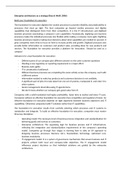Samenvatting
SUMMARY enterprise architecture (EA) as a strategy - BOOK Ross & weill
- Instelling
- Tilburg University (UVT)
full summary of the book enterprise architecture as a strategy for TU course enterprise architectures includes all chapters needed for exam
[Meer zien]














